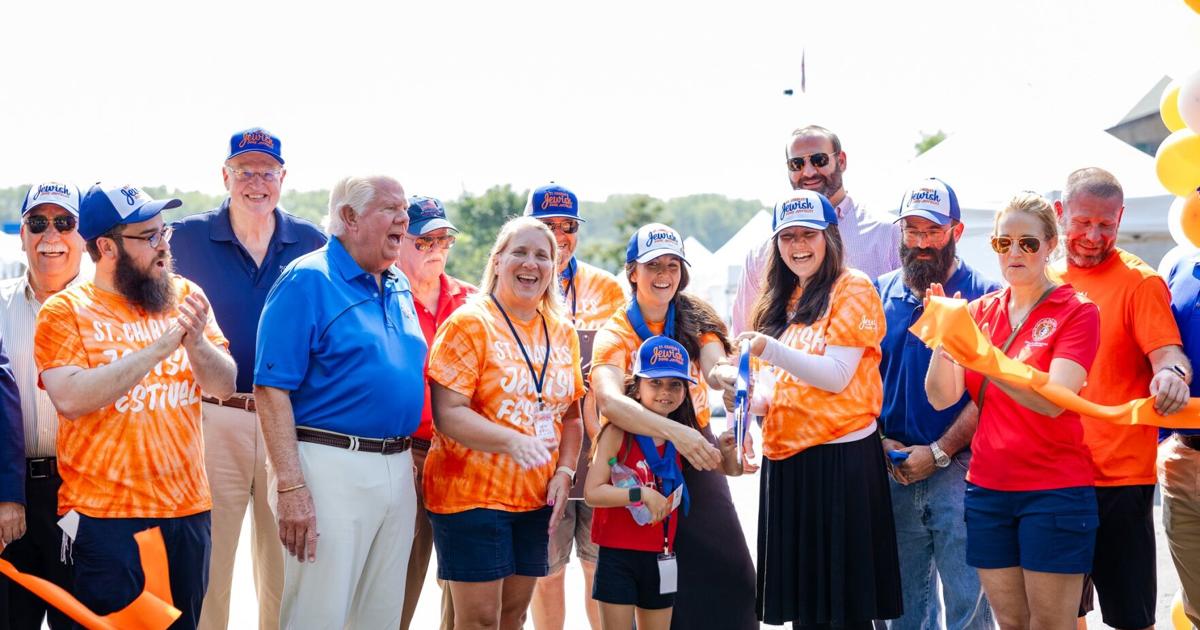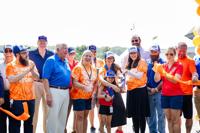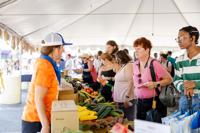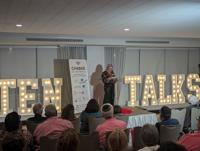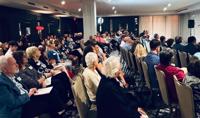
Participants at the fourth annual St. Charles Jewish Festival celebrate with St. Charles City Mayor Dan Borgmeyer. (Photo courtesy of C. Smyth Photography/St. Charles Jewish Community Chabad)
A recently-released community study highlights a Jewish population in the St. Louis region that is growing, increasingly diverse and deeply engaged in Jewish life in ways that go beyond traditional synagogue participation.

(Photo courtesy of C. Smyth Photography/St. Charles Jewish Community Chabad)
Commissioned by the Jewish Federation of St. Louis and conducted by Brandeis University’s Cohen Center for Modern Jewish Studies, the 2024 study estimates there are about 45,800 Jewish adults and children living in 26,700 households.
“We’re using this to better understand who is here, what their needs are and how we can be of service,” said Danny Cohn, the Jewish Federation of St. Louis’s CEO.
Findings included that about one quarter of Jewish households, 24%, reside in the Creve Coeur area and 22% live in St. Louis City. Eighteen percent of Jewish households reside in University City/Clayton, 12% in Chesterfield/West County and 11% in Olivette/Ladue. The remaining 13% of Jewish households are in the rest of Greater St. Louis, which includes St. Charles County. The study also showed that Jewish households include 12,600 adults and 2,800 children who are not Jewish.

A youth participates in a matzah baking class at the Chabad of Chesterfield. (Photo courtesy of Chabad of Chesterfield)
The study looked at how members of the community engage with Jewish life in a variety of ways. While some participate in religious services or holiday traditions, others connect through cultural events, education or volunteer work. While nearly half of Jewish adults said they felt very emotionally connected to the Jewish people, regardless of their level of observance, just 36% of Jewish households belong to some type of Jewish congregation located in Greater St. Louis.
Rabbi Avi Rubenfeld with the Chabad of Chesterfield said the level of synagogue membership is not surprising. Memberships are not required to participate in Chabad events.

(Photo courtesy of Chabad of Chesterfield)
“Judaism should never have an obstacle, it’s the right you were born with,” Rubenfeld said. “What this study is recognizing is what is happening. It’s like Amazon; people will take what they want, what is meaningful to them and fills their needs. (At the Chabad) we have the full spectrum of members and non members who (come to our events). We like to teach the ways of Judaism.”
Rabbi Chaim Landa with the St. Charles Jewish Community Chabad said having the geographic and demographic data from the study, along with the interests and engagement levels of the community, allows his organization to plan and make more informed decisions about the future programming and services it offers. A previous Jewish population study was what led to the opening of the St. Charles Chabad.

(Photo courtesy of Chabad of Chesterfield)
“Before opening our doors here in St. Charles, people told us ‘oh, the Jews out there – they’re not interested in their Jewish connection,’” Landa said. “But they underestimated the power of the Jewish soul and Jewish identity. The Jewish revival we are witnessing today in St. Charles County is a testament to that.”
Among younger adults, the study found a strong desire for flexible, meaningful ways to engage with Jewish life, whether through social gatherings, learning opportunities or social justice efforts. Leaders say that’s a sign of a community that is evolving because, while synagogue membership is down from a decade ago, participation in Jewish programming and informal community life has increased.
“And the fact that this study shows a spike in young Jews observing Jewish rituals – whether it be lighting Shabbat candles, attending a Passover seder or lighting a Chanukah menorah – comes as no surprise,” Landa said. “It reflects their soulful desire and thirst for a personal, authentic connection to their heritage.”
Antisemitism was also addressed in the survey. The authors of the survey point out the study was conducted during the Israel-Hamas war that began in October 2023, and during a period of rising antisemitism in the United States.
The survey found 51% of Jewish adults avoid activities out of a fear of antisemitism. Thirty-six percent avoid mentioning Israel either in person or online, and 26% say they avoid posting Jewish content online that would identify them as a Jew. Twenty-eight percent of Jewish adults said they were personally targeted by an antisemitic incident within the past year, primarily by antisemitic remarks rather than actions. Most Jewish adults are very concerned about antisemitism around the world, 79%, and they are less concerned about antisemitism in Greater St. Louis, 47%.
In spite of this, Rubenfeld said it’s a great time to be a rabbi, and a part of the Jewish community.
“People come up to me asking if I’m afraid to wear my kippah,” Rubenfeld said. “I think this is the time to be a proud Jew, not hide it. If they hate me because I’m a Jew I better be Jewish. It’s a positive side to the uptick in antisemitism. You can’t fight darkness with a sword. Shine your light. The more we can shine our light, that’s the best answer to antisemitism and the world.”
Cohn said knowing those numbers is important for the region as a whole.
“I think the general community needs to decide if this is something that they feel comfortable living with,” Cohn said. “Knowing that their neighbors are under attack, whether they’re going to stand by knowing that these statistics are true, and if there’s going to be any more allyship.”
The survey shows that the population numbers are growing and are expanding west. Rubenfeld said a new center Chabad is under construction at Conway and Hwy. 40, set to open in 2026, featuring a preschool, youth programs and expanded adult education to better serve the growing community.
“We aren’t going anywhere,” Cohn said. “If anything, the challenges we face are making us stronger, prouder and more unified. And when the Jewish community thrives, the entire St. Louis community is better for it.”
